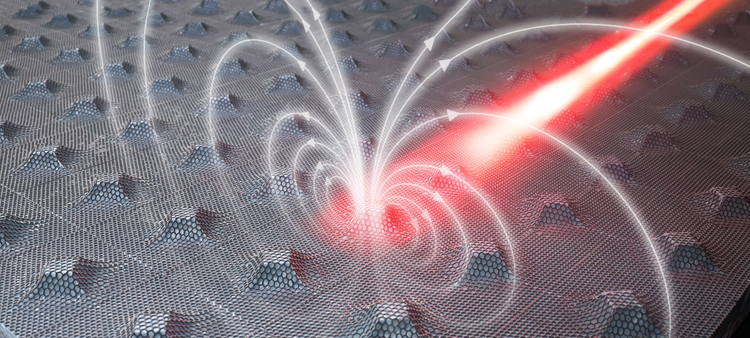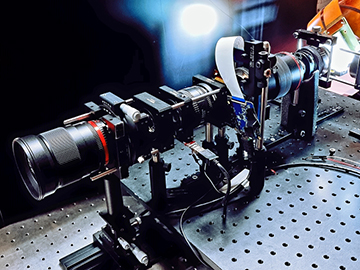
Artist’s rendering of nanopillars in strained graphene [Courtesy of D. Nam]
Materials
Toward a Graphene Laser
Team says straining the 2D material could bring a “new class” of optoelectronic devices
Developing graphene lasers has been difficult, because graphene is a zero-band-gap material. A team led by Donguk Nam at Nanyang Technological University, Singapore, has taken an intriguing step toward a graphene laser by tweaking the strains in the material’s ultrathin sheets (Nat. Commun., doi: 10.1038/s41467-021-25304-0). The team showed that engineering a periodic structure of nanoscale pillars into a graphene sheet can produce localized tensile strains, giving rise to extremely strong pseudo-magnetic fields. Those fields can affect electron transport, open up energy gaps and modify the material’s optical transitions.
The team found that the strained graphene sported carrier-relaxation times more than an order of magnitude longer than in unstrained graphene. Further research suggested that the electron behavior was consistent with the formation of pseudo-Landau levels—and, thus, the creation of an energy-gap structure—in the graphene.
The team’s demonstration and analysis of the optical properties in the strained 2D material should help with the project of “realizing the world’s strongest, thinnest lasers.” Such graphene lasers, Nam says, would “complete the last missing link toward the realization of all-graphene electronic–photonic integrated circuits … which is anticipated to revolutionize the way computer chips work.” —Stewart Wills

Using the optical setup shown here, researchers combined two different light-field display technologies. [Byoungho Lee, Seoul National University]
Imaging
Ultrahigh Definition in 3D Projection
Prototype combines best of multifocal-display and integral-imaging techniques
Researchers at Seoul National University, Republic of Korea, have melded two scene-generating techniques to create large-scale, ultrahigh-definition 3D pictures (Opt. Lett., doi:10.1364/OL.431156). The combination all-optical technique, still in prototype form, avoids the digital-processing bottlenecks associated with existing light-field displays. It also permits 3D viewing without the need for special 3D glasses or goggles, a method known as autostereoscopy.
The strong interest in headwear-free 3D viewing has led to the development of light-field displays that modulate both the direction and intensity of light. However, because of the large number of pixels in a flat-panel display and the number of rays required to represent the pixels, the tomographic technique requires huge quantities of computational processing power.
A projection-based technique called integral imaging reproduces a light field by using 2D arrays of microlenses to capture a scene in the form of an “elemental image” and reproduce the scene. The method can enlarge images better than standalone multifocal displays, but at the cost of image quality. The technique also contains a large amount of redundant data.
A team led by Optica Fellow Byoungho Lee developed a prototype device bringing together the best of both worlds. The light path of the optical structure incorporates a backlight, relay lenses on either side of a focus-tunable lens, the image plane, a microlens array, the projection lens, a macrolens array and the reconstruction plane.
Before the optical system is ready for commercial use, researchers will need to reduce the complexity of the multifocal display so it can fit into a compact projector. The lens array and focus-tunable lens will also need to be optimized to reduce aberrations. The team believes hardware for this type of 3D projection could be commercially available within two or three years. —Patricia Daukantas

Atomically thin LED semiconductor on a flexible substrate. [Ali Javey/Berkeley Lab]
Devices
LED Efficiency
Researchers at the University of California, Berkeley, and the Lawrence Berkeley National Laboratory, USA, may have found a remarkably simple way around an efficiency roadblock for one cutting-edge class of LEDs (Science, doi: 10.1126/science.abi9193). The team has shown that applying a mechanical strain of less than 1% to transition-metal dichalcogenides (TMD) can change the material’s electronic structure enough to allow near-100% light emission efficiency (that is, photoluminescence quantum yield), even at high brightness levels. The result, the team says, could enable a new generation of LED devices that avoid efficiency erosion as brightness increases.
The team’s analysis suggests that the strain’s impact on quantum yield relates to the presence of “saddle points,” or areas of van Hove singularities, in the semiconductor’s band structure. Slightly bending the material reshapes the band structure, moving the saddle points sufficiently so that the van Hove singularities don’t favor exciton–exciton annihilation, or nonradiative decay of exictons. That, in turn, allows more excitons to recombine radiatively—and boosts the photoluminescence quantum yield. —Stewart Wills

A perovskite-on-silicon tandem solar cell. [Oxford PV]
Energy
Perovskite/Silicon Solar Cells
In a recent study, researchers at the firm Oxford PV, UK, suggest that the next viable step for the photovoltaics industry is the tandem solar cell (Appl. Phys. Lett., doi: 10.1063/5.0054086). In particular, they outline the company’s success in creating a commercial perovskite/silicon tandem device with power conversion efficiency of 29.52%, which surpasses the upper theoretical limit of crystalline silicon solar cells (29.5%).
For their tandems, the researchers used silicon for the bottom cell and perovskite for the top cell. The tandem cells are heavy and rigid, with a size and shape that matches traditional silicon solar cells.
“Our final product can produce at least 20% more power output compared with conventional silicon cells,” said Laura Miranda Pérez, study author and Head of Materials Research at Oxford PV. “The much higher efficiencies of our solar cell are very well suited as a premium product for space-constrained areas, such as rooftops. You get more power from the same area.” Oxford PV is now completing installation of the world’s first perovskite-on-silicon production line in Germany with hopes to enter the market by 2022.
The company has “a roadmap setting the pathway to 33% solar cells,” said Miranda Pérez. “At the same time, we are looking at next-generation devices which potentially can reach efficiencies as high as 39%.” —Meeri Kim
![]()
Isaac Nape is the lead author on a new study on measuring entanglement dimension. [Wits University]
Communications
Quantum Entanglement Dimension
The ability to entangle photons in high-dimensional states could improve both the security and capacity of quantum communication. But scientists currently struggle to measure entanglement purity and dimensionality in a reliable yet straightforward way. Now, an international group of researchers has come up with what it describes as a “simple, fast and direct” technique for determining these quantities. The team has demonstrated its approach experimentally, over a wide range of noise levels (Nat. Commun., doi: 10.1038/s41467-021-25447-0).
A team led by Andrew Forbes of the University of the Witwatersrand, South Africa, and colleagues from the United Kingdom and Taiwan has devised a new scheme that yields detailed information on both a system’s dimensionality and purity—even though the number of measurements involved scales only linearly with these quantities. It does so by recording the “visibility” of interference measurements between two particles that are entangled in multiple dimensions. Forbes likens the tool to a quantum version of the game of Cluedo (known in North America as Clue). “If you guess Professor Plum in the bathroom with the candlestick,” says Forbes, “then the visibilities tell you how many of your guesses are right.”
Forbes says that they are looking to complement other techniques. One application where the group’s scheme might be particularly well suited is the measurement of noise and its impact on entanglement dimensions in real-world quantum communication links. —Edwin Cartlidge

Operophtera brumata caterpillar, a focus of the recent study. [Gucio_55/Getty Images]
Conversation
LED Streetlights May Harm Insects
Increases in white-LED lighting may be tied to reductions in abundance and disruptions of normal feeding behavior for a nocturnal caterpillar
Researchers from the United Kingdom have discovered potential unintended negative consequences of LED streetlights on insect populations (Sci. Adv., doi: 10.1126/sciadv.abi8322). Their experiments reveal that LEDs reduce caterpillar abundance and disrupt feeding behavior more than sodium bulbs, suggesting that the ongoing shift towards LED outdoor lighting could translate to detrimental effects for ecosystem processes.
Douglas Boyes of the UK Center for Ecology & Hydrology (UKCEH) and his colleagues focused on nocturnal moth caterpillars. The results showed that the abundance of caterpillars in hedgerows under LED street lights was 52% lower than in nearby unlit areas, compared with 41% lower under sodium lighting. Along the edges of grass fields, numbers of caterpillars under LEDs were one-third lower than in unlit areas, whereas sodium lights had little effect on population.
As a possible solution, the researchers recommend reducing the intensity of LED streetlights through dimming, as well as using filters to reduce blue wavelengths of light that are most harmful to insects. —Meeri Kim

[Luminate NY]
Industry
Luminate Names 2021 Winners
In an online event on 30 September, Luminate NY, the business accelerator centered in Rochester, NY, USA, announced the winners of its 2021 graduating class of emerging companies in optics, photonics and imaging (OPI). The five companies tapped by the program will receive a total of more than US$2 million in follow-on funding to support their business growth.
The event, sponsored by Optica, showcased ten start-up firms that had participated in the 2021 Luminate competition, which its managing director, Optica Fellow Sujatha Ramanujan, called “the largest OPI accelerator on Earth.” The 2021 competition marked the fourth annual round for the Luminate project.
Taking the top prize of US$1 million was the Portland, OR-based PreAct Technologies, which is developing an integrated sensing-and-processing platform for the automotive industry.
Other honors, accompanied by six-figure USD awards of follow-on funding, went to Princeton, NJ-based Andluca Technologies; Cambridge, MA-based DynoCardia; Somerville, MA-based Mesodyne; and Rochester, NY-based Owl Autonomous Imaging. An audience vote gave Wilmington, DE-based Layer Metrics Inc. a US$10,000 “Audience Choice” award. —Stewart Wills
Laser Weapons for UK Defense
The UK Ministry of Defense (MOD) awarded three contracts worth £72.5-million (US$99 million) to industry consortia that will develop demonstrations of directed-energy weapons for UK naval and army vehicles.
Thales Group, based in Belfast, Northern Ireland, will lead two of the three contracts. One of these will aim at producing a high-powered laser weapon system for detecting, tracking and destroying unmanned aerial vehicles (UAVs), or drones. The demo laser system is to be installed on a Royal Navy Type 23 frigate by 2023.
A second Thales-led team will develop a radio-frequency system for a UK Army MAN support vehicle. The system will be designed to track air, land and sea targets, and blast electromagnetic energy to gum up the target’s critical electronic systems.
The consortium for the third contract is led by Raytheon UK, headquartered in Essex, England. It will work toward providing a high-energy laser weapon system that would be fitted onto one of the UK Army’s Wolfhound land vehicles. Raytheon says the system, which would target UAVs, uses an electro-optical sensor that “prosecutes ... threats with precision and relative ease.”
Jeremy Quinn, the UK Minister of Defense Procurement, noted in an MOD press release that the investment flags the ministry’s “commitment to provide the armed forces with truly advanced capabilities.” —Stewart Wills
www.osa-opn.org/news/1121-weapons

[Getty Images]
Academia
Authorship Disputes
A research team in North America reports that women researchers encounter authorship disputes more frequently than their male counterparts (Sci. Adv., doi: 10.1126/sciadv.abe4639). The team surveyed more than 5,500 researchers who published at least one collaborative paper. The analysis revealed that the pattern is more pronounced in the natural sciences and engineering, where the gender gap is wider compared with fields such as medical and social sciences.
Though the team did not deeply investigate the cause of gender disparity in authorship disputes, Chaoqun Ni, the study’s first author and an information scientist at the University of Wisconsin–Madison, USA, says the survey shows that men tend to devalue the types of work that women are often associated with, such as technical work. Another suspected reason is that there may typically be fewer women in a given field. The inequality in gender representation can create power dynamics, possibly leading to more authorship disputes for women, Ni says, though there is not yet empirical evidence for this hypothesis.
Ni says funding agencies and scientific societies can set clear guidelines on how to determine the authorship, which can mitigate future disputes. However, she thinks cultural change is imperative when it comes to discussing solutions. —Karen Kwon
Edwin Cartlidge, Patricia Daukantas and Meeri Kim are freelance science writers. Karen Kwon is OPN’s associate editor. Stewart Wills is OPN’s senior editor. Alessia Kirkland is OPN’s creative director.
Book Reviews
Check out reviews of the following titles online:
- Biomedical Optical Sensors, R. De Le Rue, H.P. Herzig, M. Gerken (eds.), (review by Barry R. Masters)
- Applications of Nonlinear Fiber Optics, G.P. Agrawal, (review by Bogdan Hoanca)
- Photodetectors: Devices, Circuits and Applications, S. Donati, (review by Christian Brosseau)
- Nano and Quantum Optics, U. Hohenester, (review by Barry R. Masters)
